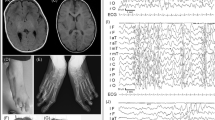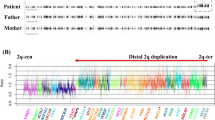Abstract
THE Greig cephalopolysyndactyly syndrome (GCPS) is an auto-somal dominant disorder affecting limb and craniofacial development in humans1,2. GCPS-affected individuals are characterized by postaxial polysyndactyly of hands, preaxial polysyndactyly of feet, macroephaly, a broad base of the nose with mild hypertelorism and a prominent forehead. The genetic locus has been pinpointed to chromosome 7pl3 by three balanced translocations associated with GCPS in different families3,4,19. This assignment is corroborated by the detection of two sporadic GCPS cases carrying overlapping deletions in 7pl3 (ref. 7), as well as by tight linkage of GCPS to the epidermal growth factor receptor gene in 7pl2–13 (ref. 8). Of the genes that map to this region, those encoding T cell receptor-γ, interferon-β2, epidermal growth factor receptor, and Hox1.4, a potential candidate gene for GCPS, have been excluded from the region in which the deletions overlap7,9. Here we show that two of the three translocations interrup the GLI3 gene, a zinc-finger gene of the GLI-Krüppel family already localized to 7pl3 (refs 5, 6). The breakpoints are within the first third of the coding sequence. In the third translocation, chromosome 7 is broken at about 10 kilobases downstream of the 3' end of GLI3. Our results indicate that mutations disturbing normal GLI3 expression may have a causative role in GCPS.
This is a preview of subscription content, access via your institution
Access options
Subscribe to this journal
Receive 51 print issues and online access
$199.00 per year
only $3.90 per issue
Buy this article
- Purchase on Springer Link
- Instant access to full article PDF
Prices may be subject to local taxes which are calculated during checkout
Similar content being viewed by others
References
Greig, D. M. Edin. med. J. 33, 189–218 (1926).
Gollop, T. R. & Fontes, L. R. Am. J. med. Genet. 22, 59–68 (1985).
Tommerup, N. & Nielsen, F. Am. J. med. Genet. 16, 313–321 (1983).
Krüger, G. et al. Am. J. med. Genet. 32, 411–416 (1989).
Ruppert, J. M. et al. Molec. cell. Biol. 8, 3104–3113 (1988).
Ruppert, J. M., Vogelstein, B., Arheden, K. & Kinzler, K. W. Molec. cell. Biol. 10, 5408–5415 (1990).
Wagner, K., Kroisel, P. M. & Rosenkranz, W. Genomics 8, 487–491 (1990).
Brueton, L., Huson, S. M., Winter, R. M. & Williamson, R. Am. J. med. Genet. 31, 799–804 (1988).
Drabkin, H. et al. Genomics 4, 518–529 (1989).
Gessler, M. et al. Nature 343, 774–778 (1990).
Bornkamm, G. W., Pollack, A. & Eick, D. in Cellular Oncogene Activation (ed. Klein, G.) 223–273 (Dekker, New York, 1988).
Eichele, G. Trends Genet 5, 246–251 (1989).
Winter, R. & Huson, M. Am. J. med. Genet. 31, 793–798 (1988).
Pohl, T. M., Mattei, M.-G. & Rüther, U. Development 110, 1153–1157 (1990).
Rommens, J. M. et al. Am. J. hum. Genet 43, 645–633 (1988).
Jobs, A. et al. Hum. Genet. 84, 147–150 (1990).
Church, G. M. & Gilbert, W. Proc. natn. Acad. Sci. U.S.A. 81, 1991–1995 (1984).
Maniatis, T., Fritsch, E. F. & Sambrook, J. Molecular Cloning:A Laboratory Manual (Cold Spring Harbor Laboratory, New York, 1982).
Vortkamp, A. et al. Genomics (in the press).
Author information
Authors and Affiliations
Rights and permissions
About this article
Cite this article
Vortkamp, A., Gessler, M. & Grzeschik, KH. GLI3 zinc-finger gene interrupted by translocations in Greig syndrome families. Nature 352, 539–540 (1991). https://doi.org/10.1038/352539a0
Received:
Accepted:
Issue Date:
DOI: https://doi.org/10.1038/352539a0
This article is cited by
-
Functional categorization of gene regulatory variants that cause Mendelian conditions
Human Genetics (2024)
-
GLI3: a mediator of genetic diseases, development and cancer
Cell Communication and Signaling (2020)
-
Autistic symptoms in Greig cephalopolysyndactyly syndrome: a family case report
Journal of Medical Case Reports (2019)
-
Novel GLI3 variant causing overlapped Greig cephalopolysyndactyly syndrome (GCPS) and Pallister-Hall syndrome (PHS) phenotype with agenesis of gallbladder and pancreas
Diagnostic Pathology (2018)
-
Exome sequencing reveals a novel nonsense mutation of GLI3 in a Chinese family with ‘non-syndromic’ pre-axial polydactyly
Journal of Human Genetics (2016)
Comments
By submitting a comment you agree to abide by our Terms and Community Guidelines. If you find something abusive or that does not comply with our terms or guidelines please flag it as inappropriate.



